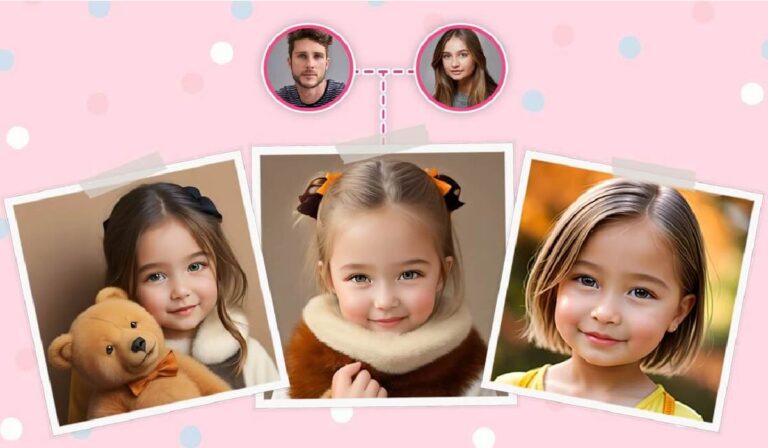In a world where artificial intelligence is redefining how we interact with technology, free AI applications now come with thrilling new and even sentimental capabilities — like creating realistic baby faces or defining pictures in remarkably detailed terms. Whether you’re interested in seeing what your future baby may look like, would like to include a creative twist on photo projects, or require help with visual content descriptions, there’s an AI tool waiting for you — and many of them are entirely free.
The Obsession with AI-Generated Baby Faces
The most trending application of AI in the last few years has been facial generation. Among all the tools, baby face generators have garnered millions of views. These tools apply deep learning models trained on thousands — even millions — of AI baby face generator free realistic baby images based on input information, usually from photographs of two grownups.
Picture uploading your own face and your partner‘s face and receiving the picture of a virtual baby with your own facial characteristics. It‘s a fun and surprisingly emotional means of envisioning the future — if you are going to have a family or simply having fun imagining one.
Some websites and apps provide this service at no cost. They might need two parent photos or permit single entry. Highly sophisticated algorithms then merge facial characteristics such as eye shape, skin color, nose shape, and others to create a realistic baby face. The end product isn‘t scientifically prescriptive, naturally, but the realism can be quite convincing — and sometimes cute.
How Does It Works ?
AI-driven baby face generators use GANs — Generative Adversarial Networks — largely. These neural networks pit two models against one another: a generator, which generates new images, and a discriminator, which compares them to real data. With time, the process tames the output to look breathtakingly realistic.
Using most baby face generators is easy:
Upload one or two clean face photos.
Let the AI work on it.
Get a generated baby face, usually in seconds.
Free apps such as MakeMeBabies, Future Baby Generator, or even certain features of Remini or FaceApp provide limited uses per day for free. Advanced results might cost a subscription, but standard functionality is available to everyone.
Describing Images with AI: More Than Just Fun
Another amazing application of free tools is AI image describer . It’s particularly useful for accessibility, content creation, and social media. AI image captioning models can look at an image and produce natural language descriptions of what is in the image — recognizing people, objects, environments, and even emotional context.
For instance, post an image of a baby playing in a garden, and an AI could respond: “A smiling baby in a white onesie sitting on a green lawn covered in flowers holds a yellow toy.” This descriptive capability assists visually impaired people in making sense of visual material, aids computerized alt text creation, and assists in cataloging photo libraries.
Free software such as Microsoft‘s Seeing AI, Google Lookout, and web-based applications such as CaptionBot or Image Caption Generator enable users to upload an image and receive an instant text description. Social media sites even use AI-generated alt text automatically.
Practical Uses of Such Tools
These technologies are not mere gimmicks — they have practical uses:
For Families and Parents: Baby face generators provide an emotional means of seeing future babies or creating innovative family collages.
For Teachers and Content Developers: AI description tools can accelerate workflow in captioning images for blogs, lessons, or presentations.
For Disability Advocates: Descriptive AI tools promote digital accessibility by having images interpreted for users who have visual impairments.
For Designers and Artists: Baby face generators can be used to stimulate character design or concept art for art projects.
The Limitations and Ethics
There are limitations to these tools, despite how enjoyable and helpful they are. The output from the AI might not consistently represent a diverse ethnic or cultural appearance, based on the training data. Privacy matters too: users should not share sensitive or identifying images on unknown sites.
Prior to utilizing any tool, particularly free tools, it‘s prudent to go through the privacy policy and terms of use. Seek out platforms that don‘t retain user photos or provide clarity regarding handling data.
Getting Started with Free AI Tools
In case you are willing to experiment, a few free tools to try include:
Baby Face Generator:
Future Baby Generator – BabyPredictor (mobile app stores)
Image Description Tools:
Microsoft Seeing AI
ImageCaptioning.AI
Google Lookout (Android)
These products are intuitive and enjoyable — simply upload your photo and leave the rest to the AI.
Conclusion
AI is making it simpler than ever to engage with digital content in personal, innovative, and accessible ways. Whether envisioning your future child or wanting to narrate images in natural language, the free AI tools available today give you access to robust solutions at your fingertips. With a few mouse clicks, you can discover possibilities previously relegated to the imagination — now fueled by the dynamic intelligence of machines.

